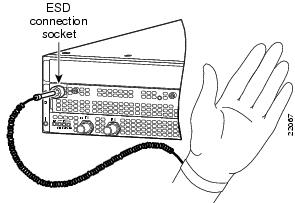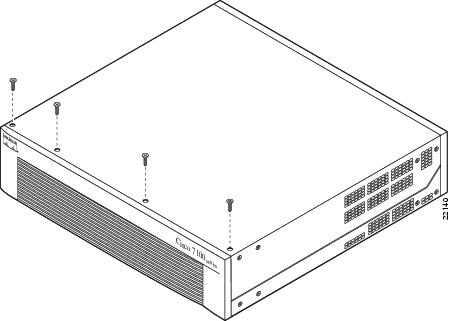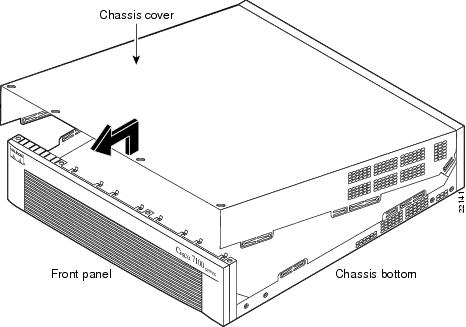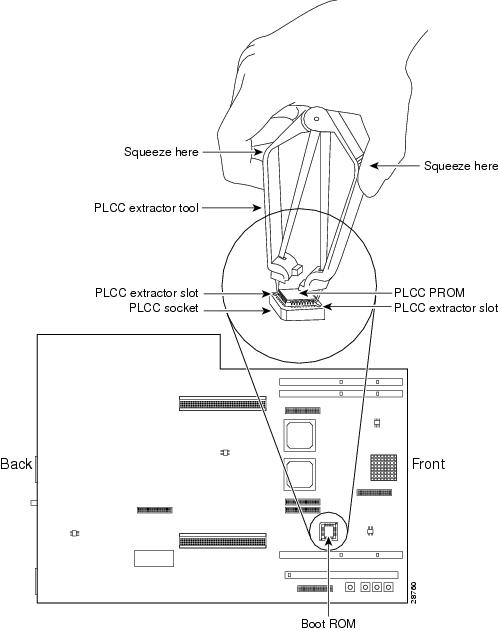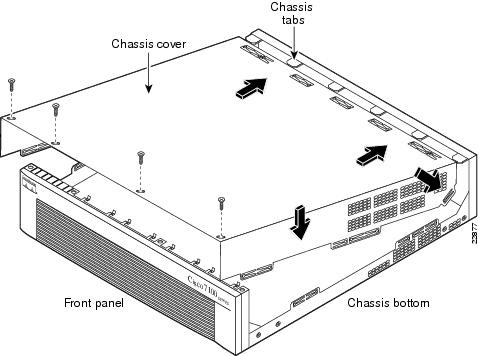 Feedback Feedback
|
Table Of Contents
Installing and Removing the Boot ROM in Cisco 7100 Series Routers
Electrical Equipment Guidelines
Electrostatic Discharge Prevention
Removing the Router from the Rack
Installing and Removing the Boot ROM in Cisco 7100 Series Routers
Product Number: BOOT-7100=
This document describes installation and removal instructions for the boot ROM in Cisco 7100 series routers.
This document contains the following sections:
•
Removing the Router from the Rack
Use this document in conjunction with the Cisco 7100 Series VPN Router Installation and Configuration Guide publication and the document Regulatory Compliance and Safety Information for Cisco 7100 Series VPN Routers.
Installation instructions for modular port adapters can be found in the individual document that ships with the port adapter. For example, if you ordered a PA-4E Ethernet port adapter, the note PA-4E Ethernet 10BaseT Port Adapter Installation and Configuration is shipped with the router.
Installation instructions for the Flash Disk can be found in the Using the Flash Disk document that shipped with the router.
Warning
Only trained and qualified personnel should be allowed to install, replace, or service this equipment. This equipment contains an energy hazard. Disconnect the system before servicing.
Required Tools
You need the following tools and equipment:
•
Electrostatic discharge (ESD)-preventive wrist strap
•
Plastic leaded chip carrier (PLCC)-type IC extractor tool
•
Number 2 Phillips screwdriver
•
Boot ROM
Safety Recommendations
For international agency compliance, safety, and statutory information for Cisco 7100 series routers, refer to the document Regulatory Compliance and Safety Information for Cisco 7100 Series VPN Routers that shipped with the router.
Any device that uses electricity must be handled carefully; follow these guidelines to ensure general safety:
•
Keep the chassis area clear and dust-free during and after installation.
•
Put the removed chassis cover in a safe place.
Warning
The safety cover is an integral part of the product. Do not operate the unit without the safety cover installed. Operating the unit without the cover in place will invalidate the safety approvals and pose a risk of fire and electrical hazards.
•
Keep tools away from walk areas where you and others could fall over them.
•
Do not wear loose clothing, jewelry (including rings and chains), or other items that could get caught in the chassis. Fasten your tie or scarf and roll up your sleeves.
•
Wear safety glasses if you are working under any conditions that might be hazardous to your eyes.
•
Do not perform any action that creates a potential hazard to people or makes the equipment unsafe.
•
The installation of the router should be in compliance with national and local electrical codes. In the United States, National Fire Protection Association (NFPA) 70, United States National Electrical Code. In Canada, Canadian Electrical Code, part I, CC22.1. In other countries, International Electrotechnical Commission (IEC) 364, part 1 through part 7.
•
Never attempt to lift an object that might be too heavy for you to lift by yourself.
•
Always power down (O) the power supplies, and unplug all power cables before opening the chassis.
•
Always unplug the power cable before installing or removing a chassis.
•
The AC-powered routers ship with a three-wire electrical grounding-type plug, which only fits into a grounding-type power outlet. This is a safety feature. The equipment grounding should be in accordance with local and national electrical codes.
•
The routers operate safely when used in accordance with their marked electrical ratings and product usage instructions.
Warning
Ultimate disposal of this product should be handled according to all national laws and regulations.
Electrical Equipment Guidelines
Warning
Before working on equipment that is connected to power lines, remove jewelry (including rings, necklaces, and watches). Metal objects will heat up when connected to power and ground and can cause serious burns or can weld the metal object to the terminals.
Warning
This unit might have more than one power supply connection. All connections need to be removed to deenergize the unit.
Follow these guidelines when you work on equipment powered by electricity:
•
Locate the emergency power switch for the room in which you are working. Then, if an electrical accident occurs, you can act quickly to power down the equipment.
•
Before working on the system, unplug the power cord.
•
Disconnect all power before doing the following:
•
Installing or removing a chassis
•
Working near power supplies
Warning
This equipment is intended to be grounded. Ensure that the host is connected to earth ground during normal use.
Warning
When installing the unit, the ground connection must always be made first and disconnected last.
•
Do not work alone if potentially hazardous conditions exist.
•
Never assume that power is disconnected from a circuit. Always check.
•
Look carefully for possible hazards in your work area, such as moist floors, ungrounded power extension cables, frayed power cords, and missing safety grounds.
•
If an electrical accident occurs, proceed as follows:
•
Use caution; do not become a victim yourself.
•
Power down the system.
•
If possible, send another person to get medical aid. Otherwise, assess the condition of the victim, and then call for help.
•
Determine if the person needs rescue breathing or external cardiac compressions; then take appropriate action.
Warning
This product relies on the building installation for short-circuit (overcurrent) protection. Ensure that a fuse or circuit breaker no larger than 120 VAC, 15A U.S. (240 VAC, 10A international) is used on the phase conductors (all current-carrying conductors).
In addition, use the guidelines that follow when working with any equipment that is disconnected from a power source, but still connected to telephone wiring or other network cabling:
•
Never install telephone wiring during a lightning storm.
•
Never install telephone jacks in wet locations unless the jack is specifically designed for wet locations.
•
Never touch uninsulated telephone wires or terminals unless the telephone line has been disconnected at the network interface.
•
Use caution when installing or modifying telephone lines.
Warning
To reduce the risk of fire, use only No. 26 American Wire Gauge (AWG) or larger telecommunication line cord.
Electrostatic Discharge Prevention
Electrostatic discharge (ESD) can damage equipment and impair electrical circuitry. ESD damage occurs when electronic components are improperly handled, and it can result in complete or intermittent failures.
Always follow ESD-prevention procedures when you remove and replace components. Ensure that the chassis is electrically connected to earth (ground). Wear an ESD-preventive wrist strap, ensuring that it makes good skin contact. Connect the grounding clip to an unpainted surface of the chassis frame to safely ground unwanted ESD voltages. To guard against ESD damage and shocks, the wrist strap and cord must operate properly. If no wrist strap is available, ground yourself by touching the metal part of the chassis.
CautionFor safety, periodically check the resistance value of the antistatic strap, which should be between 1 and 10 megohms (Mohm).
Figure 1 Attaching an Electrostatic Discharge Wrist Strap
Removing the Router from the Rack
This section describes how to remove the router from the rack. To gain access to the boot ROM, you must power down the router and remove it from the rack.
To remove the router from the rack, complete the following steps:
Step 1
Shut down all interfaces. Power down the router and disconnect site power.
Note
The power switch is part of the power supply.
Step 2
Remove all interface cables from the rear panel of the router. Ensure that the cables are adequately marked to assist you when you reconnect the cables.
Step 3
Remove the screws that secure the router to the rack. Do one side at a time. Have a second person hold the router while you remove the screws.
This complete the step for removing the Cisco 7100 series routers from the rack.
Step 4
Place the router so that the front panel is facing you. If you place the router on a table, ensure that you have clear access to all sides.
Removing the Chassis Cover
This section describes how to remove the chassis cover from the router. To gain access to the boot ROM, you must open the router chassis.
To remove the chassis cover, complete the following steps:
Step 1
Power down the router and disconnect site power.
Note
Note that the power switch is part of the power supply.
Step 2
If the router is mounted in a rack, you must remove it from the rack. (See the previous section "Removing the Router from the Rack.")
Step 3
Place the router so that the front panel is facing you. If you place the router on a table, ensure that you have clear access to all sides.
Step 4
Remove the four screws on the chassis cover. (See .)
Figure 2 Removing the Chassis Cover Screws
Step 5
Lift the chassis cover upward, and pull it away from the tabs on the rear of the chassis. (See .)
This complete the steps for removing the chassis cover from Cisco 7100 series routers.
Figure 3 Removing the Chassis Cover
Removing the Boot ROM
A PLCC-type boot ROM is located in socket U21 on Cisco 7100 series routers.
CautionA PLCC-type boot ROM does not have pins that plug into the socket; instead, the contacts are on the sides of the boot ROM and along the inner sides of the socket. Therefore, you cannot use a small flat-blade screwdriver to remove a PLCC-type boot ROM. Forcing a small screwdriver or other tool between the boot ROM and the sides of the socket to pry out the boot ROM will damage the component, the socket, or both.
To remove the boot ROM, complete the following steps:
Step 1
Attach an ESD-preventive strap between you and any unpainted router surface.
Step 2
Locate the boot ROM. (See .)
Step 3
Carefully remove the new boot ROM from its packaging and verify that it is the correct version for this upgrade. Return the new boot ROM to its packaging.
Step 4
Note the orientation of the installed boot ROM so that you can install the new boot ROM with the same orientation.
Step 5
Place the angled tips of the PLCC-type IC extractor tool beneath the corners of the boot ROM. (See .)
Figure 4 Using the PLCC-Type IC Extractor Tool to Remove the PLCC-Type Boot ROM
Step 6
Carefully squeeze the arms of the IC extractor tool until the boot ROM releases from the socket. Apply even pressure to both tips of the IC extractor tool. (See Figure 4.)
Step 7
Set the old boot ROM aside (preferably in an antistatic bag).
This completes the steps for removing the boot ROM from Cisco 7100 series routers.
Installing the Boot ROM
To install a new Boot ROM on Cisco 7100 series routers, complete the following steps:
Step 1
Remove the new boot ROM from its packaging.
Step 2
Align the new boot ROM in socket U21 (See .) Align the white dot near the boot ROM socket (indicating pin 1) with the indentation or dot on the boot ROM chip (pin 1).
Step 3
Gently press the boot ROM into the socket. The boot ROM is properly installed when the top of the boot ROM is flush with the top of the socket.
This completes the steps for installing a new Boot ROM on Cisco 7100 series routers.
Replacing the Chassis Cover
This section describes replacing the chassis cover on the router. You must remove the chassis cover to gain access to the boot ROM.
To replace the chassis cover, complete the following steps:
Step 1
Place the chassis bottom so that the front panel is facing you.
Step 2
Hold the chassis cover over the chassis bottom, and align each of the cover tabs with the chassis tabs at the top rear of the chassis. (See .)
Step 3
Lower the front of the top cover to close the chassis, and ensure the following:
•
The chassis cover tabs fit under the edge of the chassis rear panel so that they are not exposed.
•
The chassis tabs fit under the chassis cover so that they are not exposed.
•
The chassis cover side tabs on both sides fit inside the chassis side panels so that they are not exposed.
When the chassis cover is properly assembled, no tabs are visible.
Step 4
Secure the chassis cover with four screws.
Step 5
Reinstall the chassis in the rack.
Step 6
Reinstall all interface cables.
Figure 5 Replacing the Chassis Cover
Step 7
Connect the AC power cord to the site power and power up the router. The internal power supply fan should go on. For more information, refer to Chapter 3, "Installing Cisco 7100 Series Routers" in the Cisco 7100 Series VPN Routers Installation and Configuration Guide.
This completes the steps for replacing the chassis cover on Cisco 7100 series routers.
Cisco Connection Online
Cisco Connection Online (CCO) is Cisco Systems' primary, real-time support channel. Maintenance customers and partners can self-register on CCO to obtain additional information and services.
Available 24 hours a day, 7 days a week, CCO provides a wealth of standard and value-added services to Cisco's customers and business partners. CCO services include product information, product documentation, software updates, release notes, technical tips, the Bug Navigator, configuration notes, brochures, descriptions of service offerings, and download access to public and authorized files.
CCO serves a wide variety of users through two interfaces that are updated and enhanced simultaneously: a character-based version and a multimedia version that resides on the World Wide Web (WWW). The character-based CCO supports Zmodem, Kermit, Xmodem, FTP, and Internet e-mail, and it is excellent for quick access to information over lower bandwidths. The WWW version of CCO provides richly formatted documents with photographs, figures, graphics, and video, as well as hyperlinks to related information.
You can access CCO in the following ways:
•
WWW: http://www.cisco.com
•
WWW: http://www-europe.cisco.com
•
WWW: http://www-china.cisco.com
•
Telnet: cco.cisco.com
•
Modem: From North America, 408 526-8070; from Europe, 33 1 64 46 40 82. Use the following terminal settings: VT100 emulation; databits: 8; parity: none; stop bits: 1; and connection rates up to 28.8 kbps.
For a copy of CCO's Frequently Asked Questions (FAQ), contact cco-help@cisco.com. For additional information, contact cco-team@cisco.com.
Note
If you are a network administrator and need personal technical assistance with a Cisco product that is under warranty or covered by a maintenance contract, contact Cisco's Technical Assistance Center (TAC) at 800 553-2447, 408 526-7209, or tac@cisco.com. To obtain general information about Cisco Systems, Cisco products, or upgrades, contact 800 553-6387, 408 526-7208, or cs-rep@cisco.com.
Documentation CD-ROM
Cisco documentation and additional literature are available in a CD-ROM package, which ships with your product. The Documentation CD-ROM, a member of the Cisco Connection Family, is updated monthly. Therefore, it might be more current than printed documentation. To order additional copies of the Documentation CD-ROM, contact your local sales representative or call customer service. The CD-ROM package is available as a single package or as an annual subscription. You can also access Cisco documentation on the World Wide Web at http://www.cisco.com, http://www-china.cisco.com, or http://www-europe.cisco.com.
If you are reading Cisco product documentation on the World Wide Web, you can submit comments electronically. Click Feedback in the toolbar and select Documentation. After you complete the form, click Submit to send it to Cisco. We appreciate your comments
78-10156-01


